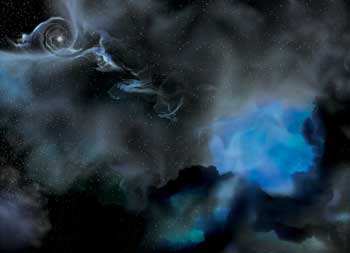IC 10 X-1

In this artist's portrayal of the IC 10 X-1 system, the black hole lies at the upper left and its companion star is on the right. The companion is shedding its outer envelope in a powerful wind, and some of this gas is captured by the black hole's powerful gravity. Credit: Aurore Simonnet/Sonoma State University/NASA.
IC 10 X-1 is the most massive known stellar black hole. IC 10 X-1 lies in the nearby dwarf galaxy, IC 10, 1.8 million light-years away, and has an estimated mass 24 to 33 times that of our Sun. Its discovery was announced in November 2007.
The reason that IC 10 X-1's mass can be determined is that it is part of a binary system. The companion is a Wolf-Rayet star. The two objects orbit around their common center of gravity once every 34.4 hours.
The nature of IC 10 X-1 was established using observations from two NASA satellites, the Chandra X-ray Observatory and the Swift Gamma-Ray Burst Explorer. The former revealed that IC 10 X-1 – the brightest X-ray source in IC 10, undergoes sharp changes in X-ray brightness. Such behavior suggests a star periodically passing in front of a companion black hole and blocking the X-rays, creating an eclipse. These eclipses were subsequently confirmed by the Swift satellite, which also supplied details about the star's orbit. The stars in IC 10 X-1 appear to orbit in a plane that lies nearly edge-on to Earth's line of sight. The Swift observations, as well as observations from the Gemini Telescope in Hawaii, told how fast the two stars go around each other. Calculations showed that the companion black hole has a mass of at least 24 Suns.
This mass is surprising large because massive stars generate powerful winds that blow off a large fraction of the star's mass before it explodes as a supernova. Theory suggests that the most massive stars in our own galaxy, the Milky Way, should leave behind black holes no heavier than about 15 to 20 Suns.
The progenitor star of IC 10 X-1 probably started its life with 60 or more solar masses. Like its host galaxy, it was probably deficient in elements heavier than hydrogen and helium. In massive, luminous stars with a high fraction of heavy elements, the extra electrons of elements such as carbon and oxygen "feel" the outward pressure of light and are thus more susceptible to being swept away in stellar winds. But with its low fraction of heavy elements, the IC 10 X-1 progenitor shed comparatively little mass before it exploded, so it could leave behind a heavier black hole.


